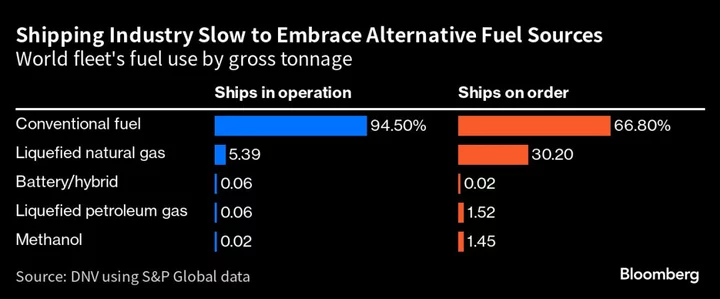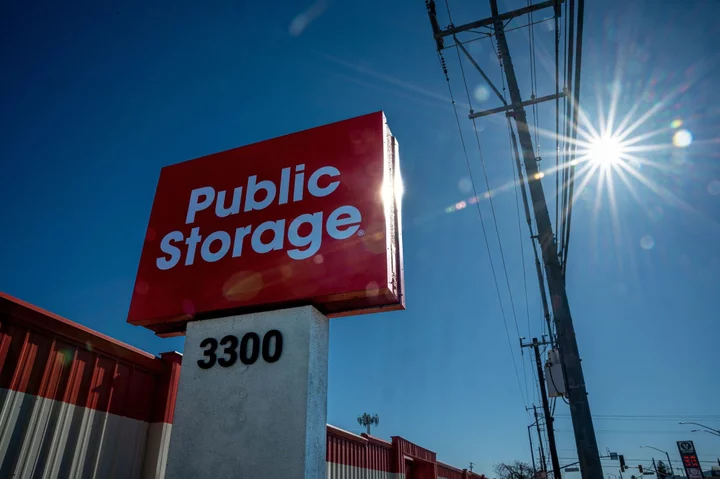The world’s largest agricultural trader hauls 225 million tons of cargo around the globe each year on hundreds of colossal vessels. Now one of those ships is being powered, in part, by wind.
The Pyxis Ocean, an 80,000-ton bulk carrier chartered by commodity giant Cargill Inc., just finished her maiden voyage from Shanghai to Singapore after the installation of two massive steel and composite-glass “sails.” It’s the first ship to be retrofitted with two WindWings, each 37.5 meters (123 feet) high. They can cut the vessel’s fuel use by roughly a fifth, designer BAR Technologies says. If the trial goes well, Cargill hopes to add sails to as many as 10 more vessels.
“It’s going to make the new fuels a lot more affordable,” said Jan Dieleman, president of Cargill’s ocean transportation business. “Wind is there for free.”
If more operators and shipowners find ways to tap renewable sources like wind to propel their mammoth fleets, the notoriously dirty shipping sector could be on course to clean up its act. The industry spews as much carbon dioxide into the atmosphere each year as 283 coal-fired power plants, according to the latest greenhouse gas study from shipping’s global regulator, the International Maritime Organization. Although shipping is under increasing regulatory pressure to cut emissions, switching away from oil products is a major logistical challenge and expensive undertaking. The vast majority of the world’s fleet runs on conventional fuel made from oil, according to a report released last year from DNV, a ship classification society. The new generation of ships on order is also far from oil-free.
Wind “is one of these technologies that — even if we switch to zero-carbon fuels in the future — the ship owner, the ship operator, the charterer will see a benefit,” said Santiago Suarez de la Fuente, a ship performance manager at classification society Lloyd’s Register.
Of course, wind-powered travel is about as far from a newly invented technology as it comes. But since the multi-mast trading vessels that once ruled the seas ceded their dominance during the 19th century to powerful steamships powered by fossil fuel, the technology has been slow to make a comeback. Pyxis Ocean joins a miniscule fleet of just over two dozen large commercial vessels already operating with some form of wind-assisted propulsion today, according to the International Windship Association.
Read More: Shipping’s Greener Fuel Quest Runs Into Climate Complications
For Cargill, America’s largest private company, curbing fuel usage would be another step toward reducing emissions in its global supply chains by 30% per ton of product by the end of the decade.
Still, quantifying precisely how big a dent wind-assisted propulsion will make in future emissions isn’t easy: Performance depends on a ship’s route, how many sails are installed and, of course, the wind. Dieleman says he isn’t expecting the Pyxis Ocean, which is owned by Mitsubishi Corp.’s shipping arm and currently en route to Brazil, to make a return on investment for between seven and 10 years, if ever — it is, after all, a prototype. That said, if fuel prices were to suddenly surge, as they did last year, payback time would shorten.
The sails were added at a Cosco shipyard in Shanghai, China. The project received some funding from the European Union. Other financial details weren’t disclosed.
Cargill says one of the advantages of rigid sails like WindWings, which were produced by Yara Marine Technologies, is the way they can be added to existing ships, not just new construction. If a vessel is already running on a clean fuel, like green methanol, wind can cut costs; if a ship is still burning oil, wind can also cut emissions. Yara Marine said some large crude carriers could fit as many as six of the sails.
“This decade, energy efficiency is the most important thing to do to your fleet,” said Claus Graugaard, chief technology officer at the Maersk Mc-Kinney Moller Center for Zero Carbon Shipping, a nonprofit.
Estimated Fuel Savings
- On an average route, each WindWing sail can save 1.5 tons of oil-derived fuel per day, according to designer BAR Technologies
- The Pyxis Ocean, which has two sails, can save about 1,095 tons a year, almost 20% of what a Kamsarmax ship typically annually consumes
- If three WindWing sails were to be installed on a Kamsarmax, fuel savings could be about 30%
- Cutting one ton of oil-derived marine fuel use equates to saving a little over three tons of CO2 emissions
Yara Marine and BAR Technologies also have a deal to install four WindWings on another ship. BAR Technologies’ Chief Executive Officer John Cooper forecasts half of the orders for new tankers and bulkers will include some sort of wind-assisted propulsion in three years.
The global shipping regulator recently set new ambitions for cutting the industry’s greenhouse gas emissions, including reaching net-zero by or around 2050. The European Union has gone further, including shipping in its emissions trading scheme starting next year. Given the push to clean up the sector, shippers may someday start to rethink how they navigate the globe.
“We’re always used to going the shortest way,” Dieleman said. “Now, you might want to go the way where there’s more wind.”









